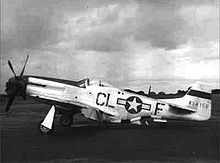RAF Wormingford
| RAF Wormingford RFC Wormingford USAAF Station 159 |
|---|


Royal Air Force Wormingford, or more simply RAF Wormingford, is a former Royal Air Force station located 6 miles (9.7 km) northwest of Colchester, Essex, England.
During World War I Wormingford was a landing ground designated for use by aircraft operating against Zeppelins. Reopened as a military airfield in 1942, it was used by both the Royal Air Force (RAF) and United States Army Air Forces (USAAF). During the war it was used primarily as a fighter airfield. After the war, it was returned to agriculture.
Today, the main runway is used by the Essex and Suffolk Gliding Club, although the concrete has been removed except where the old NW-SW runway crosses.
History
First World War
The landing ground was used by the 37th Home Defence Squadron and a Royal Aircraft Factory B.E.12 based here shot down Zeppelin number L.48 on 16/17 June 1917.[1] The landing ground was known as RFC Wormingford.[2]
Second World War
Wormingford was originally earmarked for an Eighth Heavy Bomb Group, being built by Richard Costain Ltd. and helped by a number of sub-contractors during the period 1942/1943. The airfield had a 2,000-yard main runway on an E-W axis and two intersecting runways of 1,400 yards each along with the USAAF standard fifty hardstands, two T2 hangars, one each side of the airfield, Mark II lighting and temporary building accommodation for 2,900 personnel. The technical area was on the southern side of the airfield and the camp sites dispersed to the south and east in and around the village of Fordham.[1]
However, Wormingford was surplus to
USAAF use
The airfield was assigned USAAF designation Station 159.[2]
362nd Fighter Group
The
The group consisted of the following squadrons:
- 377th Fighter Squadron[3] (E4).[4]
- 378th Fighter Squadron[3] (G8).[4]
- 379th Fighter Squadron[3] (B8).[4]
The 362nd FG flew its first mission, escorting
The group moved to RAF Headcorn in Kent on 13 April 1944.[3]
55th Fighter Group
The
The group consisted of the following squadrons:[9]
- 38th Fighter Squadron(CG)
- 338th Fighter Squadron(CL)
- 343d Fighter Squadron(CY)
Originally flying
The unit received a
The 55th Fighter Group moved to
Legacy
The United States Air Force 55th Wing in various designations, has been a front-line unit of Strategic Air Command and Air Combat Command more than 50 years.[10]
The 55th Reconnaissance Group (Very Long Range, Mapping). was activated in 1948 and assigned to Strategic Air Command. Aircraft included RB-17's and Boeing B-29 Superfortresses and RB-29's. The USAF 55th Strategic Reconnaissance Wing was activated in 1950, and was bestowed the lineage, honors and history of the World War II USAAF 55th Fighter Group in 1952.[6]
The 55th Wing is currently at
3d Scouting Force
In September 1944, the 3d Scouting Force (originally 3rd Air Division Scouting Force) was activated at Wormingford. The unit flew a combination of P-47s, P-51s and B-17s on classified missions such as scouting target visibility and reporting meteorological conditions. The unit was inactivated during June 1945.[1]
Royal Air Force use
After
Current use
With the end of military control, Wormingford was largely returned to agriculture[2] and much of the concrete broken up for aggregate. A small section of the main runway was retained and the whole of the main runway, largely grass, is now used by the Essex and Suffolk Gliding club.[1]
See also
References
![]() This article incorporates public domain material from the Air Force Historical Research Agency
This article incorporates public domain material from the Air Force Historical Research Agency
Citations
- ^ a b c d e "A Brief History of Flying at Wormingford". Essex & Suffolk Gliding Club. Retrieved 12 February 2013.
- ^ a b c "Wormingford (Bures)". Airfields of Britain Conservation Trust. Retrieved 12 February 2013.
- ^ a b c d e Maurer 1980, p. 245.
- ^ a b c WatkinsIII 2008, p. 31.
- ^ Maurer 1980, p. 244.
- ^ a b c Maurer 1980, p. 118.
- ^ Maurer 1980, p. 403.
- ^ WatkinsII 2008, p. 38.
- ^ "The 55th Fighter Group". Little Friends. Retrieved 12 February 2013.
- ^ a b c d Maurer 1980, p. 117.
- ^ "Offutt Air Force Base". United States Air Force. Archived from the original on 24 February 2012. Retrieved 12 February 2013.
- ^ "RAF Wormingford airfield". Control Towers. Retrieved 12 February 2013.
Bibliography
- Maurer, M. Air Force Combat Units of World War II. USAF Historical Division. Washington D.C., USA: Zenger Publishing Co., Inc, 1980. ISBN 0-89201-092-4.
- Watkins, B. Battle Colors - Insignia and Markings of the Eighth Air Force in World War II - Vol II (VIII) Fighter Command. Atglen, Pennsylvania, USA: Shiffer Publishing Ltd., 2008. ISBN 0-7643-2535-3.
- Watkins, B. Battle Colors - Insignia and Markings of the Ninth Air Force in World War II - Vol III. Atglen, Pennsylvania, USA: Shiffer Publishing Ltd., 2008. ISBN 978-0-7643-2938-8.


